Legacy
Greg Martin
Liberty Wildlife Contributor
When entire Roman legions disappeared over the course of a few days, slaughtered to the last man in the fog-choked forests of bygone Germania, there was no way to bring them back. There was no succor for their families; it haunted Augustus for the rest of his storied life. Only one thing remained that could possibly give the Roman Empire closure following one of its very worst defeats:
Its eagles.
According to the legend of Rome’s founding, brothers Romulus and Remus watched for divine indication to decide which of them should rule, based on the number and prominence of eagles they saw overhead. Centuries later, it wasn’t enough for Augustus to simply send another force to avenge his defeat; he wanted, needed, his eagles back. A legion’s eagle standard was its pride made manifest. It was the will of Rome in physical form.
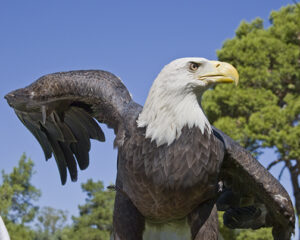 There is a reason why the eagle stands foremost amongst the civilizations of the world as the ultimate emblem of grace, dignity, strength, and the profound. There’s something inherently impressive in an eagle, something that communicates directly with us. Nomads of the Asian steppes, Aztecs in Mesoamerica, Italians in classical Rome, and medieval monarchs across Europe, to say nothing of the United States today and countless other cultures, looked at the same creature across space and time and came away with, more or less, the same message. That says much about both the worthiness of eagles and the common threads binding humanity together.
There is a reason why the eagle stands foremost amongst the civilizations of the world as the ultimate emblem of grace, dignity, strength, and the profound. There’s something inherently impressive in an eagle, something that communicates directly with us. Nomads of the Asian steppes, Aztecs in Mesoamerica, Italians in classical Rome, and medieval monarchs across Europe, to say nothing of the United States today and countless other cultures, looked at the same creature across space and time and came away with, more or less, the same message. That says much about both the worthiness of eagles and the common threads binding humanity together.
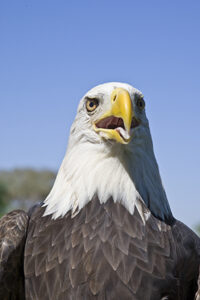 Liberty Wildlife’s namesake Bald Eagle recently passed away after three well-lived decades in our care. The injury that stole Liberty from the wild opened her path into countless venues, lives, and hearts. All of our non-releasable Education Ambassadors do invaluable work on behalf of their species, but Liberty wasn’t just any bird: she was an eagle, bearer of a legacy that marches back as far as we care to look. Despite her injury – or perhaps because she stood so proudly with it – she confidently exuded the very same majesty that so inspired the Caesars, the Great Khans, the founders of Mexico City and the crowned heads of nearly every nation in human history who looked for something that embodied all that is noble and best. As a Bald Eagle, she was a living reminder of the ideals this nation was founded upon; it’s a rare animal that can effortlessly represent liberty (freedom), Liberty (Wildlife), and Liberty (herself as a Bald Eagle), all at once.
Liberty Wildlife’s namesake Bald Eagle recently passed away after three well-lived decades in our care. The injury that stole Liberty from the wild opened her path into countless venues, lives, and hearts. All of our non-releasable Education Ambassadors do invaluable work on behalf of their species, but Liberty wasn’t just any bird: she was an eagle, bearer of a legacy that marches back as far as we care to look. Despite her injury – or perhaps because she stood so proudly with it – she confidently exuded the very same majesty that so inspired the Caesars, the Great Khans, the founders of Mexico City and the crowned heads of nearly every nation in human history who looked for something that embodied all that is noble and best. As a Bald Eagle, she was a living reminder of the ideals this nation was founded upon; it’s a rare animal that can effortlessly represent liberty (freedom), Liberty (Wildlife), and Liberty (herself as a Bald Eagle), all at once.
Like Augustus bringing his standards home, the legacy of eagles – and of this eagle – transcends a single lifetime. Our facility’s mission to rescue, rehabilitate, and educate, is as much a reflection of her as she was of it. The avian Education Ambassadors of Liberty Wildlife don’t represent the volunteers and the staff; we represent them, and the onus is on us to be worthy of them. Liberty the Bald Eagle remains the standard of the organization; it’s her name that means so much. Not ours.
Augustus understood two thousand years ago: an eagle is more than a bird. It’s a symbol. A legacy. What we do is her legacy.

And a legacy is forever.
Keeping a Nature Journal
Gail Cochrane
Liberty Wildlife Volunteer
Looking for a fresh way to connect with the natural world? Consider taking up nature journaling. It’s easy and infinitely rewarding. So, bring your journal along and step outdoors to sit for a while in your natural Sonoran Desert home.
Find a place to settle in, look around, and sniff the air. Open your journal and make note of the qualities of the day. Season, weather, time of day all influence what you will see. Recording these conditions will put your observations in context. And when you look back through the pages of your journal, those details will help remind you of that very day.
As you sit and open your senses, absorb the feel of being in the open air. You might notice aromas wafting from a nearby desert lavender, or hear the buzzing of native bees working around the tiny flowers of a wolfberry bush. Sharpen your pencil and wake up your mind. Make some notes.
Recently I sat near an ironwood tree – I know these keystone species attract many desert plants and animals. Everything was still for some time, but then there was a flash of movement deep in the tree and I saw a small bird moving. To my ears came a thunking sound, the rat-a-tat-tat of a woodpecker. This slender fellow wore a bright red cap and was decorated with bold stripes of black and white. In a moment his mate joined him to explore the ironwood.
I was thrilled. Such a flash of color in the muted landscape, such an unusual sighting. I made a very rough sketch and jotted down some notes. When I got home, I verified in my field guide that I’d seen a pair of ladder-backed woodpeckers. And I was able to add a few details to my sketch.
Back in the field, I noted two plants growing near the base of the ironwood tree, a globe mallow and a wolfberry. The wolfberry is a woody shrub with tiny leaves and nearly indistinct yellow flowers. But the bees were already there, in early December to gather nectar. The globe mallow is a perennial, rising from dead sticks when the rains come. Their heart-shaped leaves and thick stems are covered in a fine down that can be prickly.
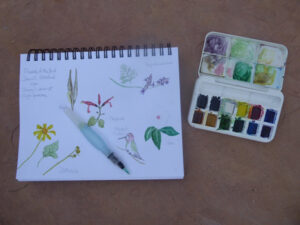 In my journal, I sketched a bit of each plant, one next to the other. Careful study highlighted contrasts such as woody twig to a succulent stem. I noted the difference in the size of leaves and thought about how the two plants feed themselves with such different structures. I tried to draw the miniature flower on the wolfberry and thought about the tasty red berries that would come later…and when? Something to record in my journal when it happens.
In my journal, I sketched a bit of each plant, one next to the other. Careful study highlighted contrasts such as woody twig to a succulent stem. I noted the difference in the size of leaves and thought about how the two plants feed themselves with such different structures. I tried to draw the miniature flower on the wolfberry and thought about the tasty red berries that would come later…and when? Something to record in my journal when it happens.
The globe mallow has lovely cup-shaped flowers, but has not bloomed yet. When I return to this place in a few weeks, the flowers will be out and I’ll want to record the beautiful hues. Nature journalists need color!
When I purchased my notebook, I got a wet/dry that can be used for watercolor painting. I found an adorable small set of watercolor paints and an ingenious watercolor brush that holds water in the handle. When I sit and marvel at the glory of the globemallow bloom, I can try to replicate the shades. Pastel pencils would be another approach, but don’t be afraid to add color to your nature journal. Capturing the hues in the landscapes and the plants and animals will add the beauty of nature to your pages.
Remember that a nature journal is not about creating a perfect art piece. It is a recording, but it is also a place to explore ideas and ask questions about what you see. What type of native bee is visiting the wolfberry? Jot down all your thoughts and questions. When you get back inside you can do some research and add to your previous impressions and sketches. With practice, you will observe and identify themes and patterns in the world around you. It’s all about getting to know nature better, and a field journal is a great way to do so.
A resource for interested journalers: Academy.allaboutbirds.org has an online course on Nature Journaling and Field Sketching.
Raptor Hunting Techniques
(Part 2)
Claudia Kirscher
Liberty Wildlife Volunteer
Birds of prey exhibit an extraordinary variety of hunting techniques and styles. These are generally dictated by the type of prey targeted, habitat of prey, and specialized hunting “equipment” of the raptor.
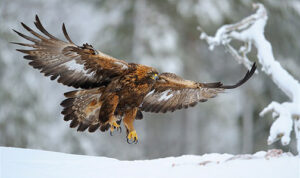
The Golden Eagle is a powerful apex predator. They soar to hunt and kill with their talons. They often work in pairs while hunting with one eagle driving the prey to its waiting partner. Unlike the Bald Eagle, they favor partially or completely open country around mountains, hills, and cliffs. Common prey includes marmots, rabbits, fox, slow-flying birds such as wild turkeys, and even prey as large as pronghorn or white-tailed deer. They have been known to knock goats off cliffs.
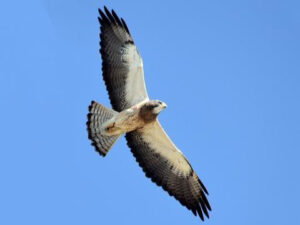 Swainson’s Hawks are soaring hunters. Insects are a large part of their diet plus small mammals and occasional small birds. They are also opportunistic hunters, often following, in the air or on the ground, a tractor tilling or cutting grain crops. The insects and mice stirred up by this activity are easy meals. Swainson’s have also been known to look for smoke, position themselves ahead of a fire and then will catch animals escaping the fire.
Swainson’s Hawks are soaring hunters. Insects are a large part of their diet plus small mammals and occasional small birds. They are also opportunistic hunters, often following, in the air or on the ground, a tractor tilling or cutting grain crops. The insects and mice stirred up by this activity are easy meals. Swainson’s have also been known to look for smoke, position themselves ahead of a fire and then will catch animals escaping the fire.
Crested Caracaras are considered part of the falcon family, but have completely different hunting techniques. They are primarily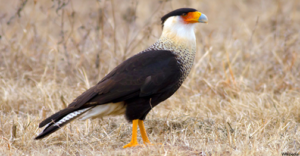 scavengers, often following and feeding with Turkey Vultures. They, like the Swainson’s Hawk, have learned to follow farm equipment harvesting fields to pick off rodents and insects. They can kill small prey, but rarely do.
scavengers, often following and feeding with Turkey Vultures. They, like the Swainson’s Hawk, have learned to follow farm equipment harvesting fields to pick off rodents and insects. They can kill small prey, but rarely do.
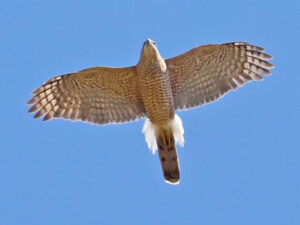
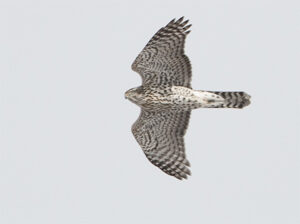 The Cooper’s Hawk and the Northern Goshawk are both members of the Accipiter family and share similar physical characteristics and hunting styles. They combine a variety of techniques: Ambush, aerial pursuit, soaring, and perched. They both use the element of surprise. They are exceptionally nimble going after prey in forests and shrubby areas. Short, rounded wings and long tails that act as rudders help them navigate between trees and dense foliage. They are both primarily bird hunters but will supplement with small mammals.
The Cooper’s Hawk and the Northern Goshawk are both members of the Accipiter family and share similar physical characteristics and hunting styles. They combine a variety of techniques: Ambush, aerial pursuit, soaring, and perched. They both use the element of surprise. They are exceptionally nimble going after prey in forests and shrubby areas. Short, rounded wings and long tails that act as rudders help them navigate between trees and dense foliage. They are both primarily bird hunters but will supplement with small mammals.
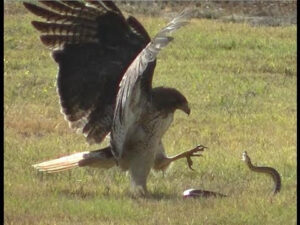
Red-tailed Hawks are large bulky birds who use perched and soaring hunting. Stealth, excellent vision, long broad wings, and talon strength are their tools. They have a wide variety of prey including rodents, birds, and the occasional snake (including rattlesnakes). The Red-tailed Hawk sits and surveys for prey. They are the most common hawk seen perched on a fence, pole or tree along the roadside.
And just for fun …….
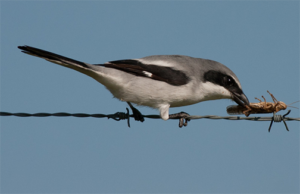
The Loggerhead Shrike is a carnivorous passerine (perching songbird family) that is sometimes called a mini-raptor or even an honorary raptor given their hooked beak and predatory habits. They hunt a wide variety of insects, small rodents, and small birds. Their nickname is The Butcherbird because of its habit of impaling its prey on barbed wire fences or spiny branches. These caches are storage areas for future meals. Talk about specialized!
Kid Stuff
Carol Suits
Nurturing Nature
Kid Stuff has some experiments and fun activities for you!
Do you need to wrap presents soon? Here’s a fun way to make your own gift-wrap.
http://www.sciencefun.org/kidszone/experiments/marbled-gift-wrap/
These experiments are all about the weather. One shows you how to make a sundial to tell time, another how to create rain, and the last one is to measure rainfall amounts.
http://www.sciencefun.org/kidszone/experiments/sun-dial/
http://www.sciencefun.org/kidszone/experiments/make-it-rain/
http://www.sciencefun.org/kidszone/experiments/rain-rain-dont-go-away-rain-gauge/
This link describes how to grow a bean plant. Be sure to look at the extra experiments you can do with your bean plant. http://www.sciencefun.org/kidszone/experiments/blossoming-beans/
Fossils are the remains or traces of plants and animals that lived long ago. You can make your own fossil stamp. http://www.sciencefun.org/kidszone/experiments/fun-fossil-stamps-and-desktop-fossils/
Jokes, trivia and puzzles to try!
http://www.sciencefun.org/kidszone/jokes/


